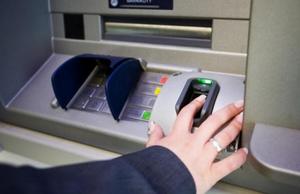BiometricsBiometric ATMs appearing in Poland, U.S. lags far behind
More banks around the world are installing biometric ATMs that use finger vein scanning technology to authenticate a customer’s identity before they can withdraw cash; unlike current fingerprint scanners, the finger vein scanner uses infrared light to analyze the micro veins beneath the surface of the finger; banks around the world including Japan, Mexico, and Africa have begun installing these new ATMs, but they have yet to appear in the United States; critics worry that the ATMs are too invasive and a study last year found that 50 percent of Europeans would not use them; banks in the United States lack the financial incentive to install these devices

Another layer of secure authentication // Source: crazyengineers.com
Last year Poland’s BPS bank began installing biometric ATMs in Warsaw, making it the first country to adopt this technology in Europe. The ATM relies on finger vein scanning technology to authenticate a customer’s identity before they can withdraw any cash.
Unlike current fingerprint scanners, the finger vein scanner, developed by Japanese firm Hitachi, uses infrared light to analyze the micro veins beneath the surface of the finger. This technique is known as “sub-dermal analysis.” Peter Jones, the head of security and solutions at Hitachi in Europe, said, “This is a substantially more reliable technique than using fingerprints.”
“Our tests indicate there is a one in a million false acceptance rate — that’s as good as iris scanning, which is generally regarded as the most secure method,” Jones added.
According to Jones the machine is impossible to fool because an individual’s finger veins are impossible to replicate as they are below the surface of the skin.
“And before you ask, no — it doesn’t work with fingers that have been chopped off,” he said.
BPS began installing these biometric ATMs at every one of its branches in an effort to combat identity fraud.
Criminals have found increasingly clever ways of stealing a customer’s card information to defraud banks of money. One technique includes installing ATM skimming devices to capture a customer’s card data and PIN number.
Biometric ATMs are most common in Japan where banks have installed more than 80,000 of them. It is estimated that they are used by more than 15 million customers.
Japan began installing the new ATMs after the government issued a law in 2006 that made banks liable for withdrawals made by criminals using stolen bank cards.
So far biometric ATMs have failed to appear in the United States, but elsewhere these ATMs have begun to turn up in Mexico, South America, Africa, and the Middle East.
Many people are still wary of using such biometric technology, citing privacy concerns.
“If these banks are going to make biometrics an attractive proposition, they’re going to have to start being much more transparent about what they do with their customer’s personal data. They have to show that this type of sensitive information does not belong to them, but to us,” Cohen said.
In a survey conducted by the European ATM Security Team last year, 50 percent of respondents said they would not use ATMS if they used finger vein technology to verify their identity.
Jones believes that banks in the United States have not adopted biometric ATMs because they are expensive to install and lack the incentive to do so.
“It’s generally the customer who foots the bill for fraud, and the banks have already factored that into their business model. Add to that the fact that it costs thousands of dollars to install a new ATM — and it’s just not worth it from their point of view,” Jones explains.
